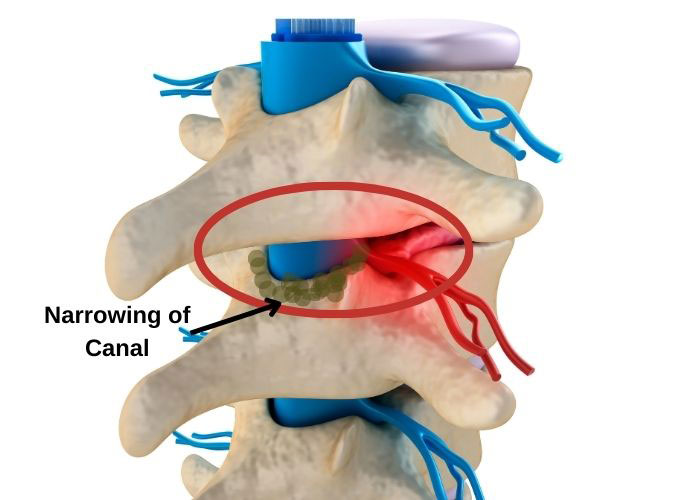Lumbar Stenosis Specialist
Do you have pain in your lower back that is causing numbness or tingling in the buttocks or legs? If so, you may have a spinal condition known as lumbar stenosis. Lumbar stenosis, if left untreated can cause permanent damage and incredible pain. Lumbar stenosis expert, Doctor Andre M. Samuel, offers both surgical and non-surgical treatment options for patients in Clear Lake, Houston, and Sugar Land, Texas area, who are experiencing lumbar stenosis or neurogenic claudication. Contact Dr. Samuel’s team today!

What is lumbar stenosis?
The last five vertebrae of the spinal column form the lumbar spine. The bony openings of these vertebrae house the network of nerves that carry electrical messages all throughout the body. As individuals age, these bony openings may narrow causing pressure and irritation to the nerve roots. This narrowing of the spinal canal is called spinal stenosis; more specifically, lumbar stenosis is when the lumbar vertebrae are directly affected by this narrowing. While adults over the age of 60 are most at risk of developing lumbar stenosis, a small number of individuals have a congenital variation where they are born with an already narrowed spinal canal.
What is neurogenic claudication?
Neurogenic claudication is a condition that affects the motor nervous system of the lower extremities and can cause leg fatigue. Neurogenic claudication can be classified as a symptom as it is the product of an underlying spinal or neurological condition, most often lumbar spinal stenosis. Individuals with neurogenic claudication may experience sharp pain above the knees that radiates down to the lower leg and is made worse with weight-bearing activities such as standing and walking. A key characteristic of this condition is the sharp pain resolves within minutes of sitting down. Dr. Andre M. Samuel, orthopedic spine specialist serving the Clear Lake, Houston, Sugar Land, Texas area, has the knowledge and understanding, as well as substantial experience, in treating patients who have experienced lumbar stenosis with or without neurogenic claudication.

What are the symptoms of lumbar stenosis?
The most common complaint of lumbar stenosis is a burning pain in the buttocks that radiates into one of the lower extremities. Patients with severe lumbar stenosis may notice this pain radiates as far as the foot and into the toes. Some other common symptoms of lumbar stenosis include:
- Lower back pain
- Numbness and/or tingling in the buttocks and lower extremities
- Decreased muscle strength
- Difficulty lifting the foot, also known as foot drop
- In rare instances, a loss of bladder and/or bowel control may occur in cauda equina syndrome; this is a medical emergency that requires immediate medical attention
How is lumbar stenosis diagnosed?
Dr. Samuel will obtain a medical history and perform a physical and neurological examination to diagnose lumbar stenosis. The lower back and lower extremities are evaluated for any signs of muscle weakness, decreased pulses, or abnormalities in the nerve reflexes. Diagnostic imaging studies, such as magnetic resonance imaging (MRI) or computed tomography (CT), are useful in delineating the affected lumbar nerve root.
What is the treatment for lumbar stenosis?
Non-surgical treatment:
While conservative treatment options do not widen the spinal canal, most patients report symptom relief with these non-surgical therapies. Non-steroidal anti-inflammatory medications (NSAIDs) are recommended to decrease inflammation and pain in the muscles and nerves. Lower back and abdominal exercises through physical therapy can help improve the strength, function, and range of motion of the lower extremities. Dr. Samuel can provide an epidural steroid injection directly adjacent to the irritated nerve root to further alleviate pain and inflammation symptoms.
Surgical treatment:
However, surgical intervention may be necessary for individuals with continued symptoms affecting their quality of life despite conservative management. There are two approaches that can be implemented to surgically correct lumbar stenosis: minimally invasive laminectomy and minimally invasive spinal fusion. Dr. Samuel will determine the best option upon reviewing patient-specific factors such as current symptoms, medical history, and desired outcomes.


